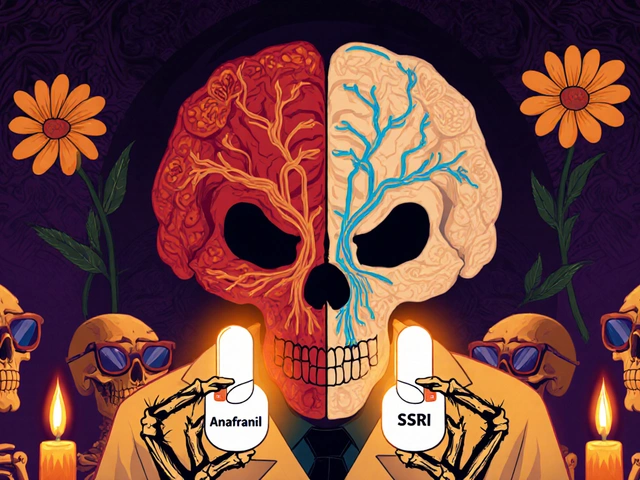OCD Medication Comparison Tool
Compare Anafranil with other OCD medications to understand the key differences in effectiveness, side effects, and suitability for your situation.
Select medications to compare
Choose up to 3 medications to see a side-by-side comparison.
Comparison Results
| Medication | Effectiveness for OCD | Key Side Effects | Half-Life | Drug Interactions | Considerations |
|---|
Choosing the right medication
This comparison shows key differences between medications. Remember, the best choice depends on your individual situation, symptoms, and medical history. Always consult with your healthcare provider before making any changes to your treatment.
If you’re taking Anafranil (clomipramine) for OCD or depression, you’ve probably wondered if there’s a better option. Maybe your side effects are too much. Maybe it’s not working as well as you hoped. Or maybe you’re just tired of the constant balancing act between relief and discomfort. You’re not alone. Many people on Anafranil look for alternatives - and for good reason. It’s one of the oldest and most potent drugs for OCD, but it’s also one of the hardest to tolerate.
What Anafranil Actually Does
Clomipramine is a tricyclic antidepressant (TCA) that works by increasing serotonin and norepinephrine in the brain. It was first approved in the 1980s and remains one of the few medications with strong evidence for treating obsessive-compulsive disorder (OCD), not just depression. Unlike most antidepressants that focus mainly on serotonin, Anafranil hits both serotonin and norepinephrine hard. That’s why it can be more effective for severe OCD cases - but also why it causes more side effects.
Studies show Anafranil reduces OCD symptoms in about 60% of patients after 8-12 weeks. That’s better than placebo, and comparable to SSRIs like fluoxetine (Prozac) or sertraline (Zoloft). But here’s the catch: nearly half of people stop taking it because of side effects like dry mouth, dizziness, weight gain, constipation, or heart rhythm changes.
Why People Look for Alternatives
Most people don’t quit Anafranil because it doesn’t work. They quit because it’s hard to live with.
- It can cause drowsiness so bad you can’t drive or work.
- Weight gain of 10-20 pounds is common within months.
- It slows your heart rate and can trigger arrhythmias - especially if you have any heart condition.
- It interacts with many other drugs, including common painkillers and even some cold medicines.
- You need regular blood tests to check levels and liver function.
For many, these side effects outweigh the benefits - even when OCD symptoms are under control. That’s why alternatives matter.
SSRIs: The Most Common Alternatives
SSRIs - selective serotonin reuptake inhibitors - are the first-line treatment for OCD today. They’re safer, easier to tolerate, and just as effective for most people.
Here’s how the top SSRIs stack up against Anafranil:
| Medication | Effectiveness for OCD | Common Side Effects | Half-Life | Drug Interactions |
|---|---|---|---|---|
| Anafranil (Clomipramine) | High (60-70% response) | Drowsiness, weight gain, dry mouth, constipation, heart rhythm issues | 20-30 hours | High (CYP2D6, CYP3A4) |
| Sertraline (Zoloft) | High (55-65% response) | Nausea, insomnia, sexual dysfunction | 26 hours | Moderate |
| Fluoxetine (Prozac) | High (50-60% response) | Agitation, insomnia, weight loss | 4-6 days | Moderate |
| Fluvoxamine (Luvox) | High (55-65% response) | Nausea, dizziness, sleepiness | 15 hours | High (CYP1A2) |
| Escitalopram (Lexapro) | Moderate-High (50-60% response) | Headache, fatigue, sexual side effects | 27-32 hours | Low |
Fluvoxamine is the only SSRI approved specifically for OCD in the U.S. and Europe - but sertraline and fluoxetine are used just as often because they’re cheaper and more widely available. All SSRIs have fewer physical side effects than Anafranil. No heart monitoring needed. No risk of fatal overdose in typical doses. That’s why most psychiatrists start with SSRIs now.

What About Other Tricyclics?
Some people ask: What about other tricyclic antidepressants like amitriptyline or nortriptyline? The answer is simple: they don’t work for OCD like Anafranil does.
Clomipramine is unique among TCAs because of its strong serotonin reuptake inhibition. Amitriptyline is mostly a norepinephrine drug - great for nerve pain, terrible for OCD. Nortriptyline is even weaker on serotonin. If you’re switching from Anafranil and want to stay in the TCA class, you’re out of luck. There’s no other TCA with the same OCD-specific effect.
SNRIs and Other Options
SNRIs like venlafaxine (Effexor) and duloxetine (Cymbalta) boost both serotonin and norepinephrine - similar to Anafranil, but more selectively. Some small studies show venlafaxine helps OCD, especially when SSRIs fail. But the evidence isn’t as strong. It’s usually a second- or third-line option.
For treatment-resistant OCD, doctors sometimes add:
- Clonazepam - a benzodiazepine for short-term anxiety relief
- Antipsychotics like risperidone or aripiprazole - used in low doses to boost SSRIs
- Deep brain stimulation - for severe, unresponsive cases
But these aren’t direct replacements. They’re add-ons. If you want to ditch Anafranil entirely, SSRIs are still your best bet.
When Anafranil Might Still Be the Best Choice
Don’t assume SSRIs are always better. There are real cases where Anafranil wins.
- You’ve tried at least three SSRIs at high doses for 12 weeks each - and nothing worked.
- Your OCD symptoms are severe: you spend 6+ hours a day in rituals, can’t work or leave the house.
- You have comorbid conditions like panic disorder or chronic pain - Anafranil helps both.
- You’re an adult, not a teen - Anafranil has more safety data in adults than some newer drugs.
One 2023 study in the Journal of Clinical Psychiatry found that patients who switched from SSRIs to Anafranil after failure saw a 40% greater reduction in OCD symptoms than those who stayed on SSRIs. For a small group, Anafranil is the difference between functioning and being trapped.

How to Switch Safely
Never stop Anafranil cold turkey. Withdrawal can cause dizziness, nausea, brain zaps, and even seizures. Tapering takes time - usually 4 to 8 weeks.
If you’re switching to an SSRI:
- Reduce Anafranil by 25% every 7-10 days.
- Start the SSRI at a low dose (e.g., 10 mg sertraline) while tapering.
- Wait 2-4 weeks after stopping Anafranil before increasing the SSRI dose.
- Monitor for serotonin syndrome: agitation, rapid heartbeat, high fever, confusion.
Some doctors use a cross-taper - lowering Anafranil while slowly raising the SSRI - but that’s risky and should only be done under close supervision.
What About Natural Alternatives?
You’ll find online claims about NAC (N-acetylcysteine), inositol, or St. John’s Wort helping OCD. Some small studies show modest effects. But none come close to the power of Anafranil or SSRIs.
St. John’s Wort can interact dangerously with Anafranil and cause serotonin syndrome. NAC is being studied, but it’s not a replacement. Inositol might help mild anxiety, but not severe OCD.
Therapy - especially exposure and response prevention (ERP) - is the most effective non-drug option. Many people do better with ERP + an SSRI than with Anafranil alone.
Final Thoughts
Anafranil isn’t obsolete. But it’s no longer the first choice. For most people, SSRIs offer similar results with far fewer risks. If you’re on Anafranil and struggling with side effects, talk to your doctor about switching. You don’t have to suffer to get relief.
If Anafranil is working for you and you’re tolerating it, don’t fix what isn’t broken. But if you’re stuck in a cycle of drowsiness, weight gain, or heart palpitations - there are better paths. You just need the right plan.
Is Anafranil better than SSRIs for OCD?
Anafranil can be more effective for severe OCD that hasn’t responded to SSRIs, but it’s not better overall. SSRIs are safer, easier to tolerate, and work just as well for most people. Doctors now start with SSRIs and only turn to Anafranil if those fail.
Can I take Anafranil and an SSRI together?
It’s possible, but risky. Combining Anafranil with an SSRI increases the chance of serotonin syndrome - a potentially life-threatening condition. This is only done in rare, treatment-resistant cases under strict supervision with frequent monitoring.
How long does it take for Anafranil to work for OCD?
Unlike depression, OCD often takes longer to respond. Most people start seeing improvement after 6-8 weeks, but full effects can take 10-12 weeks or more. Patience is key - and don’t give up before 12 weeks unless side effects are unbearable.
Does Anafranil cause weight gain?
Yes, weight gain is very common - often 10 to 20 pounds within the first 6 months. It’s caused by increased appetite and slower metabolism. Some people gain more. If weight gain is a major concern, switching to an SSRI like fluoxetine (which can cause weight loss) might help.
Is Anafranil safe for long-term use?
Anafranil can be used long-term if you’re tolerating it and your doctor monitors you. Regular ECGs are needed to check heart rhythm, and blood tests track liver function and drug levels. Many people stay on it for years with no issues - but the risks add up over time, so it’s not ideal unless necessary.








